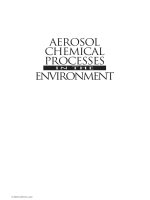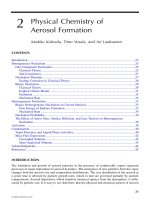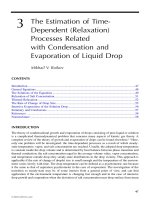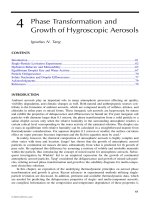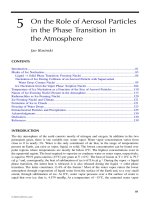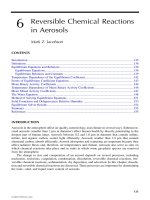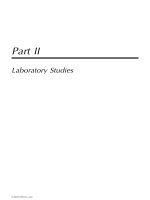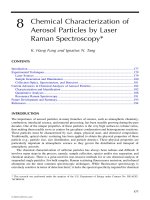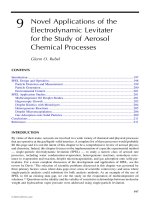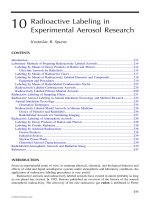Veterinary Medicines in the Environment - Chapter 2 ppt
Bạn đang xem bản rút gọn của tài liệu. Xem và tải ngay bản đầy đủ của tài liệu tại đây (405.34 KB, 14 trang )
7
2
Uses and Inputs of
Veterinary Medicines
in the Environment
Alistair Boxall, Mark Crane, Christian Corsing,
Charles Eirkson, and Alex Tait
2.1 INTRODUCTION
Veterinary medicines are widely used to treat disease and protect the health of
animals. Dietary-enhancing feed additives (growth promoters) are also incor-
porated into the feed of animals reared for food in order to improve their growth
rates. Release of veterinary medicines to the environment occurs directly, for
example, from the use of medicines in sh farms. It also occurs indirectly, via the
application of animal manure (containing excreted products) to land or via direct
excretion of residues onto pasture (Jørgensen and Halling-Sørensen 2000; Boxall
et al. 2004).
Over the past 10 years, the scientic community has become increasingly
interested in the impacts of veterinary medicines on the environment, and there
have been signicant developments in the regulatory requirements for the envi-
ronmental assessment of veterinary products. A number of groups of veterinary
medicines, primarily sheep dip chemicals (Environment Agency 1997), sh farm
medicines (Jacobsen and Berglind 1988; Davies et al. 1998), and anthelmintics
(Wall and Strong 1987; Ridsdill-Smith 1988; McCracken 1993; Strong 1993;
McKellar 1997), have been well studied.
This chapter considers publicly available data on the use and inputs to the
environment of veterinary medicines and provides an overall context for subse-
quent chapters in this book.
2.2 VETERINARY MEDICINE USE
Data on amounts used and sales of veterinary medicines are available from sev-
eral sources, including survey data obtained from Intercontinental Medical Sta-
tistics (IMS) Health, the UK Veterinary Medicines Directorate (VMD) data on
the sales of antimicrobial substances and sheep dip chemicals in the United King-
dom and data in the published literature (e.g., Sarmah et al. 2006; Kools et al.
2008). It is not, however, possible to obtain a complete data set for usage of all
© 2009 by the Society of Environmental Toxicology and Chemistry (SETAC)
8 Veterinary Medicines in the Environment
veterinary medicines. However, taken together these data sets are likely to reect
the general picture of usage of veterinary medicines in Europe, North America,
and elsewhere. Major active substances used are shown in Table 2.1.
2.2.1 PARASITICIDES
Ectoparasiticides are used to control external parasites in livestock. Endoparasiti-
cides are used to control internal parasites, and endectocides are used to treat both
internal and external parasites. Ectoparasiticides, endoparasiticides, and endec-
tocides are used to treat parasites in a wide range of animals. If uncontrolled,
ectoparasites (mites, blowies, lice, ticks, headies, and keds) can severely affect
the welfare of farm animals. Several product types are available, and a range of
active substances is approved for use (Table 2.1). Kools et al. (2008) estimated
that approximately 194 tons of parasiticides are used in Europe in 1 year, but
data on usage of individual active substances are limited. The available data on
the usage of ectoparasiticides on sheep (Liddel 2000; Pepper and Carter 2000)
indicate that the organophosphate compound diazinon is the most widely used
active ingredient, followed by the synthetic pyrethroids such as cypermethrin.
Data from the United Kingdom indicate that in cattle, the most widely used para-
siticide is ivermectin, followed by oxfendazole, eprinomectin, doramectin, and
fenbendazole, with morantel, moxidectin, and permethrin used in much lower
amounts (Boxall et al. 2007).
2.2.2 ANTIBACTERIALS
Antibacterials are used in the treatment and prevention of bacterial diseases
(Gustafson and Bowen 1997). Although their veterinary use follows similar prin-
ciples to those used in human medicines, there are some differences. The most sig-
nicant is that livestock and poultry are raised in large numbers, and it is therefore
necessary to treat the entire ock or herd at risk. An extensive review of antibacte-
rial use across the world is provided in Sarmah et al. (2006). In the United States, it
is estimated that 16000 tons of antimicrobial compounds are used annually. These
include ionophores, sulfonamides, tetracyclines, uoroquinolones, C-lactams, and
aminoglycosides. In the European Union, approximately 5400 tons of antibiotics
are used per year (Kools et al. 2008). The type of antibacterial used depends on
the EU member state. For example, in the United Kingdom, the Netherlands, and
France, the tetracyclines are the biggest usage class, whereas in Sweden, Finland,
and Denmark, the C-lactams and cephalosporins comprise the largest usage class
(Kools et al. 2008). In New Zealand, 93 tons of antibiotics are used per year, the
majority of which are ionophores (Sarmah et al. 2006). In Kenya, around 15 tons
of antibiotics are used per year, the majority of which are tetracyclines and poten-
tiated sulfonamides (i.e., the products contain a mixture of a sulfonamide and
trimethoprim; Sarmah et al. 2006).
© 2009 by the Society of Environmental Toxicology and Chemistry (SETAC)
Uses and Inputs of Veterinary Medicines in the Environment 9
TABLE 2.1
Major groups of veterinary medicines
Group Chemical class Major active ingredients
Antibacterials Tetracyclines Oxytetracycline, chlortetracycline,
tetracycline
Sulphonamides Sulfadiazine, sulfamethazine,
sulfathiazole
C-lactams
Amoxicillin, ampicillin, penicillin G,
benzylpenicillin
Aminoglycosides Dihydrostreptomycin, neomycin,
apramycin
Macrolides Tylosin, spiramycin, erythromycin,
lincomycin
Fluoroquinolones Enrooxacin
2,4-diaminopyrimidines Trimethoprim
Pleuromutilins Tiamulin
Parasiticides Macrolide endectins Ivermectin, doramectin, eprinomectin
Pyrethroids Cypermethrin, deltamethrin
Organophosphates Diazinon
Pyrimidines Pyrantel, morantel
Benzimidazoles Triclabendazole, fenbendazole
Others Levamisole
Hormones Altrenogest, progesterone,
medroxyprogesterone,
methyltestosterone, estradiol benzoate
Antifungals Biguanide/gluconate Chlorhexidine
Azole Miconazole
Other Griseofulvin
Coccidiostats/
antiprotozoals
Amprolium, clopidol, lasalocid,
maduramicin, narasin, nicarbazin,
robenidine, toltrazuril, diclazuril
Growth promoters Monensin, salinomycin, avophospholipol
Aquaculture treatments Oxytetracycline, amoxicillin, orfenicol,
emamectin benzoate, cypermethrin,
teubenzuron, hydrogen peroxide
Anaesthetics Isourane, halothane, procaine, lido/
lignocaine
Euthanasia products Pentobarbitone
Analgesics Metamyzole
Tranquilizers Phenobarbitone
Nonsteroidal anti-
inammatory drugs
(NSAIDs)
Phenylbutazone, caprofen
Enteric bloat preps Dimethicone, poloxalene
© 2009 by the Society of Environmental Toxicology and Chemistry (SETAC)
10 Veterinary Medicines in the Environment
2.2.3 COCCIDIOSTATS AND ANTIPROTOZOALS
Coccidiostats and antiprotozoals are often incorporated into feedstuffs for medici-
nal purposes. This includes prophylactic use for the prevention of diseases such as
coccidiosis and swine dysentery and therapeutic use for the treatment of diseases.
Apart from 1 individual substance (dimetridazole), usage data are largely unavail-
able (Boxall et al. 2004). However, the following compounds are considered to
be potential major usage compounds within the therapeutic group: amprolium,
clopidol, lasalocid acid, maduramicin, narasin, nicarbazin, and robenidine hydro-
chloride. Major usage protozoal compounds include toltrazuril, decoquinate, and
diclazuril.
2.2.4 ANTIFUNGALS
Antifungal agents are used topically and orally to treat fungal and yeast infec-
tions. The most common uses include treatment of ringworm and yeast infections.
The publicly available data indicate that the major active substances used are
chlorhexidine, miconazole, and griseofulvin.
2.2.5 AQUACULTURE MEDICINES
A range of substances are used in aquaculture to treat mainly sea lice infesta-
tions and furunculosis. The medicines may be applied by injection, in feed, or
via cage treatments. A range of substances are used, including oxytetracycline,
oxolinic acid, amoxicillin, co-trimazine, orfenicol, saraoxacin, emamectin ben-
zoate, cypermethrin, deltamethrin, teubenzuron, azamethiphos, and hydrogen
peroxide.
2.2.6 HORMONES
Although they are currently banned as growth promoters in the European Union,
hormones have other restricted uses, including induction of ovulatory estrus, sup-
pression of estrus, systemic progesterone therapy, and treatment of hypersexual-
ity. It has been estimated that in the European Union, the amount of hormones
used in animal treatment is around 4.5 tons per year (Kools et al. in press). The
major active substances used are altrenogest and progesterone.
2.2.7 GROWTH PROMOTERS
Growth promoters (also called “digestive enhancers”) are mainly antibiotic com-
pounds added to animal feedstuffs to improve the efciency of food digestion.
From 1993 to 1998, sales of antimicrobial growth promoters remained largely
static. However, in 1999, sales fell by 69%. This decrease is considered to be
due to a ban by the European Union in mid-1999 of those growth promoters sus-
pected to confer cross-resistance to antimicrobials in human medicine (VMD
© 2009 by the Society of Environmental Toxicology and Chemistry (SETAC)
Uses and Inputs of Veterinary Medicines in the Environment 11
2001), although use of growth promoters continues in other regions of the world.
Usage data on individual antimicrobial compounds used as growth promoters
are limited. Compounds identied as potentially major usage growth promoters
include monensin, avophospolipol, and salinomycin sodium.
2.2.8 OTHER MEDICINAL CLASSES
Several other therapeutic groups are used as veterinary medicines in signicant
quantities, including anesthetics, euthanasia products, analgesics, tranquilizers,
nonsteroidal anti-inammatory drugs (NSAIDs), and enteric preparations.
In addition to the above, the following “other” therapeutic groups have also
been identied as potentially important: antiseptics, steroids, diuretics, cardio-
vascular and respiratory treatments, locomotor treatments, and immunological
products. However, insufcient information is available to identify individual
compounds and usage within each of these groups.
2.3 PATHWAYS TO THE ENVIRONMENT
Veterinary medicines enter the environment by a number of different pathways.
Currently the environmental risk assessment of veterinary medicinal products is
only concerned with emission at or after use of the product (i.e., application and
excretion; Montforts 1999). However, emissions may occur at any stage in a prod-
uct’s life cycle, including during production and during the disposal of the unused
drugs, containers, and waste material containing the product (e.g., manure, sh
water, and other dirty water; Montforts 1999). A summary of the possible emis-
sion routes to the environment is given below. The importance of individual
routes into the environment for different types of medicine will vary according
to the type of treatment, the route of administration, and the type of animal being
treated.
2.3.1 EMISSIONS DURING MANUFACTURING AND FORMULATION
During the manufacture of an active pharmaceutical ingredient (API) and for-
mulation of the nished drug product, raw materials, intermediates, and/or the
active substance may be released to the air, to water in wastewater, and to land in
the form of solid waste. During manufacture, the main route of release of drugs
into the environment is probably via process waste efuents produced during the
cleaning of API and manufacturing equipment used for coating, blending, tab-
let compressing, and packing (Velagaleti et al. 2002). Biological and chemical
degradation processes such as biotransformation, mineralization, hydrolysis, and
photolysis are thought to remove most drug residues before process waste efu-
ents or sludge solids are discharged to surface waters or sewage treatment works
or are released to land (Velagaleti et al. 2002). In addition, a number of practices
are often implemented by industry to reduce waste generation and material losses.
© 2009 by the Society of Environmental Toxicology and Chemistry (SETAC)
12 Veterinary Medicines in the Environment
These include process optimization, production scheduling, materials tracking,
and waste stream segregation (US Environmental Protection Agency [USEPA]
1997). Losses to the environment arising during the manufacture or formulation
of veterinary medicinal products are likely to be minimal.
Manufacturing plants employ several treatment methodologies and technolo-
gies to control and treat emissions and minimize the amount of waste produced.
These include the use of condensers, scrubbers, adsorbent lters, and combustion
or incineration for recovery and removal in air emissions. Neutralization, equal-
ization, activated sludge, primary clarication, multimedia ltration, activated
carbon, chemical oxidation, and advanced biological processes may be used for
treatment of wastewaters (USEPA 1997).
2.3.2 AQUACULTURE
Chemotherapeutic medicines used in sh farming are limited to anti-infective
agents for parasitic and microbial diseases, anesthetic agents, and medical dis-
infectants. Drugs are commonly administered as medicated feed, by injection,
or, in the case of topical applications, as a bath formulation. Bacterial infections
in sh are usually treated using medicated food pellets that are added directly to
pens or cages (Samuelsen et al. 1992; Hektoen et al. 1995).
When infected, cultured sh show reduced appetite and thus feed intake. Con-
sequently, a large proportion of medicated feed is not eaten, and this passes through
the cages and is available for distribution to other environmental compartments.
Furthermore, the bioavailability of many antibacterial agents is relatively low, and
drugs may also enter the environment via feces and urine (Björklund and Bylund
1991; Hustvedt et al. 1991). In recent years, improved husbandry practices have
reduced the amount of waste feed generated, and more recently authorized medi-
cines have greater bioavailability (F > 95%). Nevertheless, deposition of drugs
from uneaten feed or feces on, or in, under-cage sediment can be a major route
for environmental contamination by medicines used in aquaculture (Jacobsen and
Berglind 1988; Björklund et al. 1991; Lunestad 1992). Once present on or in sedi-
ment, compounds may also leach back into the water column. During periods of
treatment, some of the drugs entering the environment in waste feed and feces are
also taken up by exploitative wild sh, shellsh, and crustaceans (Björklund et al.
1990; Samuelsen et al. 1992; Ervik et al. 1994; Capone et al. 1996).
When topical applications of chemotherapeutants are made, sh are usually
crowded into a small water volume for treatment (Grave et al. 1991; Burka et al.
1997). Concentrated drugs are added directly to the water of open net pens or
ponds, net pens enclosed by a tarpaulin, or tanks. Waste efuent is then either
released into the surrounding water column or subject to local wastewater treatment
and recycling (lters, settlement basins, and ponds; Grave et al. 1991; Burka et al.
1997; Montforts 1999). In addition, sludge recovered from wastewater-recycling
activities may be applied directly to land or sold as fertilizer (Montforts 1999).
© 2009 by the Society of Environmental Toxicology and Chemistry (SETAC)
Uses and Inputs of Veterinary Medicines in the Environment 13
2.3.3 AGRICULTURE (LIVESTOCK PRODUCTION)
Large quantities of animal health products are used in agriculture to improve
animal care and increase production. Some drugs used in livestock production are
poorly absorbed by the gut, and the parent compound or metabolites are known
to be excreted in the feces or urine, irrespective of the method of application
(Campbell et al. 1983; Donoho 1987; Magnussen et al. 1991; Stout et al. 1991;
Sommer et al. 1992). During livestock production, veterinary drugs enter the envi-
ronment through removal and subsequent disposal of waste material (including
manure or slurry and “dirty” waters), via excretion of feces and urine by grazing
animals, through spillage during external application, via washoff from farmyard
hard surfaces (e.g., concrete), or by direct discharge to the environment.
With all hormones, antibiotics, and other pharmaceutical agents administered
either orally or by injection to animals, the major route of entry of the product
into the environment is probably via excretion following use and the subsequent
disposal of contaminated manure onto land (Halling-Sørensen et al. 2001). Many
intensively reared farm animals are housed indoors for long periods at a time.
Consequently, large quantities of farmyard manure, slurry, or litter are produced,
which are then disposed of at relatively high application rates onto land (ADAS
1997, 1998; Montforts 1999). Although each class of livestock production has
different housing and manure production characteristics, the emission and distri-
bution routes for veterinary medicines are essentially similar. As well as contami-
nating the soil column, it is possible for veterinary medicines to leach to shallow
groundwater from manured elds or even reach surface water bodies through sur-
face runoff (Nessel et al. 1989; Hirsch et al. 1999; Hamscher et al. 2000a, 2000b,
2000c; Meyer et al. 2000). In addition, drugs administered to grazing animals or
animals reared intensively outdoors are deposited directly to land or to surface water
in dung or urine, exposing soil organisms to high local concentrations (Sommer
and Overgaard Nielsen 1992; Strong 1992, 1993; McCracken 1993; Sommer et al.
1993; Strong and Wall 1994; Halling-Sørensen et al. 1998; Montforts 1999).
Another signicant route for environmental contamination is the release of
substances used in topical applications. Various substances are used externally on
animals and poultry for the treatment of external or internal parasites and infec-
tion. Sheep in particular suffer from a number of external insect parasites for which
treatment and protection are sometimes obligatory. The main methods of external
treatment include plunge dipping or sheep dipping; pour-on formulations; and the
use of showers or jetters. With all externally applied veterinary medicines, both
diffuse and point source pollution can occur. Sheep-dipping activities provide
several routes for environmental contamination. In dipping practice, chemicals
may enter watercourses through inappropriate disposal of used dip, through leak-
age of used dip from dipping installations, and from excess dip draining from
treated animals. Current disposal practices rely heavily on spreading used dip
© 2009 by the Society of Environmental Toxicology and Chemistry (SETAC)
14 Veterinary Medicines in the Environment
onto land (Health and Safety Executive 1997; Ministry of Agriculture Fisheries
and Food 1998).
Washoff of chemicals from the eeces of recently treated animals to soil,
water, and hard surfaces may occur on the farm, during transport, or at stock
markets. Some market authorities insist animals are dipped before entering the
market to restrict the spread of disease, thus creating the potential for contami-
nated runoff from uncovered standing areas (Armstrong and Philips 1998). Medi-
cines washed off, excreted, or spilled onto farmyard hard surfaces may be washed
off to surface waters during periods of rainfall.
Other major sources of pollution arising from sheep dip chemicals are emis-
sions from wool-washing plants and fellmongers (the initial processing stage of
leather production; Armstrong and Philips 1998). Monitoring data (Environment
Agency 1998) have demonstrated high numbers of Environmental Quality Stan-
dard (EQS) failures in the Yorkshire, United Kingdom area associated with the
textile industry. Although efuent produced from the wool-washing process is
normally treated for the removal of pollutants, this process is not always ade-
quately effective, and chemicals may be released in discharges from the treatment
plants. In addition, spills and leaks of untreated efuent directly to surface water
drains from both fellmongers and wool treatment plants can occur (Environment
Agency 1999).
The Environment Agency, working in partnership with representatives from
the Scottish Environment Protection Agency, VMD, National Ofce of Animal
Health, water companies, the textile industry, and sheep farmers, has produced a
strategy for reducing sheep dip chemical pollution from the textile industry that
provides detailed discussion and makes recommendations for dealing with the
problem (Environment Agency 1999).
Other topically applied veterinary medicines likely to wash off following use
include udder disinfectants from dairy units and endectocides for treating cattle
parasites. Udder washings containing anti-infective agents and contaminated
dirty water produced by dairy units may enter the environment through soak-
aways and surface water drains or via its inclusion in stored slurry and subsequent
application to land. Washoff from the coats and skin of cattle treated with pour-on
formulations can occur where the animals are exposed to rain shortly after dosing
(Bloom and Matheson 1993). Residues of drugs in washoff may accumulate in
localized high concentrations on land with high stocking densities. Contaminated
surface runoff from open cattle yards (dirty water) is often collected and subse-
quently spread onto land. In addition, residues may wash off the backs and coats
of grazing animals such as cattle and sheep that have access to surface water
bodies as drinking water.
2.3.4 COMPANION AND DOMESTIC ANIMALS
To date, the environmental fate of veterinary medicines used in companion ani-
mals (pets) has not been extensively researched. This is probably because unlike
© 2009 by the Society of Environmental Toxicology and Chemistry (SETAC)
Uses and Inputs of Veterinary Medicines in the Environment 15
production animals reared in agriculture, companion animals are kept on a
small-scale basis and are therefore not subject to mass medication. Where used,
drugs are likely to be dispersed into the environment via runoff or leaching from
on-ground fecal material (Daughton and Ternes 1999). In addition, ectoparasiti-
cides applied externally to canine species may contaminate surface water through
direct loss from the coat if the animal enters the water.
2.3.5 DISPOSAL OF UNWANTED DRUGS
Veterinary medicines may be subject to disposal at any stage during their life
cycle. It is probably fair to assume that, as with human medicines, a propor-
tion of all prescribed or nonprescribed veterinary medicines will be unused and
unwanted by the end user. The principal end users of veterinary medicines are
veterinarians, livestock producers, and domestic users. Disposal of veterinary
medicines by end users should be interpreted to include damaged, outdated, or
outmoded animal medicines, as well as used containers and packages, contami-
nated sharps, applicators, and protective clothing (Cook 1995). Users are advised
always to follow advice on the label regarding disposal and never to dispose of
such items with domestic rubbish or down the drain or toilet.
Where appropriate, product label and safety data sheets provided by manu-
facturers provide information relating to the safe disposal of veterinary medicines
and packaging. Distributors, veterinary practices, farmers, and feed compound-
ers can also contact the manufacturer or local authority for advice, especially
where large quantities of animal medicines require disposal and collection ser-
vices are operated by some local authorities for the periodic disposal of special
waste (Cook 1995). Users of companion animal products may return unwanted or
unused product to the veterinarian or local pharmacist.
In practice, methods for disposal include ushing down the toilet, incinera-
tion, and local domestic waste collection. Domestic users will undoubtedly ush
unwanted medicines down toilets or place them with the domestic refuse (Daugh-
ton and Ternes 1999). For ectoparasiticides, and in particular for sheep dips, con-
tainers should be returned to suppliers for correct disposal via high-temperature
incineration or licensed landll. In the United Kingdom, if on-farm disposal is
planned, containers (water-soluble preparations) should be triple-rinsed before
burning or burial away from watercourses or any land drains, as specied by the
1998 Code of Good Agricultural Practice for the Protection of Water. Inappropri-
ate disposal of empty containers and unwanted product by careless operators may
lead to contamination of soil and waters.
Unwanted or expired products that are returned to the manufacturer are usu-
ally disposed of through incineration or landlling at suitable sites (Velagaleti
et al. 2002). Where medicines are disposed of in sufcient quantities to unlined
landll sites, residues present in the leachate may reach shallow groundwater and
surface waters (Holm et al. 1995).
© 2009 by the Society of Environmental Toxicology and Chemistry (SETAC)
16 Veterinary Medicines in the Environment
2.4 SUMMARY
The impact of veterinary medicines on the environment will depend on several
factors, including the amounts used, animal husbandry practices, treatment type
and dose, metabolism within the animal, method of administration, environmen-
tal toxicity, physicochemical properties, soil type, weather, manure storage and
handling practices, and degradation rates in manure and slurry.
The importance of individual routes into the environment for different types
of veterinary medicines will vary according to the type of treatment and live-
stock category. Treatments used in aquaculture have a high potential to reach
the aquatic environment. The main routes of entry to the terrestrial environment
will be from the use of veterinary medicines in intensively reared livestock, via
the application of slurry and manure to land, and via the use of veterinary medi-
cines in pasture-reared animals where residues from medicines will be excreted
directly into the environment. Veterinary medicines applied to land by spreading
of slurry may also enter the aquatic environment indirectly via surface runoff or
leaching to groundwater. It is likely that topical treatments will have a greater
potential to be released to the environment than treatments administered orally
or by injection. Inputs from the manufacturing process, companion animal treat-
ments, and disposal are likely to be minimal in comparison.
This chapter has reviewed the data available in the public domain on vet-
erinary medicine’s usage and pathways to the environment. Although there is a
large body of data available, there are clearly several gaps in these data and in our
understanding of the impacts of veterinary medicines on the environment. On the
basis of this review, the following gaps can be identied.
1) Usage data are unavailable for many groups of veterinary medicines and for
several geographical regions, which makes it difcult to establish whether
these substances pose a risk to the environment. It is, therefore, recom-
mended that usage information be obtained for these groups, including the
antiseptics, steroids, diuretics, cardiovascular and respiratory treatments,
locomotor treatments, and immunological products. Better usage data will
assist in designing more robust hazard and risk management strategies
that are tailored to geographically explicit usage patterns.
2) From the information available, it appears that inputs from aquaculture
and herd or ock treatments are probably the most signicant in terms
of environmental exposure. This is mainly because many aquaculture
treatments are dosed directly into the aquatic environment, and herd or
ock treatments may be excreted directly onto pasture. However, the
relative signicance of novel routes of entry to the environment from
livestock treatments, such as washoff following topical treatment and
farmyard runoff, and aerial emissions, has not generally been consid-
ered. For example, the signicance of exposure to the environment from
the disposal of used containers or from discharge from manufactur-
ing sites should be investigated further. In addition, substances may be
© 2009 by the Society of Environmental Toxicology and Chemistry (SETAC)
Uses and Inputs of Veterinary Medicines in the Environment 17
released to the environment as a result of off-label use and poor slurry
management practice. The signicance of these exposure routes is cur-
rently unknown.
REFERENCES
ADAS. 1997. Animal manure practices in the pig industry: survey report. July. Wolver-
hampton (UK): ADAS Consulting Ltd.
ADAS. 1998. Animal manure practices in the dairy industry: survey report. March.
Wolverhampton (UK): ADAS Consulting Ltd.
Armstrong A, Philips K. 1998. A strategic review of sheep dipping. R&D Technical
Report P170. Bristol (UK): Environmental Agency.
Björklund HV, Bondestam J, Bylund G. 1990. Residues of oxytetracycline in wild sh and
sediments from sh farms. Aquaculture 86:359–367.
Björklund HV, Bylund G. 1991. Comparative pharmacokinetics and bioavailability of oxo-
linic acid and oxytetracycline in rainbow trout (Oncorhynchus mykiss). Xenobiotica
21:1511–1520.
Björklund HV, Råbergh CMI, Bylund G. 1991. Residues of oxolinic acid and oxytetracy-
cline in sh and sediments from sh farms. Aquaculture 97:85–96.
Bloom RA, Matheson JC. 1993. Environmental assessment of avermectins by the US
Food and Drug Administration. Vet Parasitol 48:281–294.
Boxall ABA, Fogg LA, Kay P, Blackwell PA, Pemberton EJ, Croxford A. 2004. Veteri-
nary medicines in the environment. Revs Environ Contam Toxicol 180:1–91.
Boxall ABA, Sherratt T, Pudner V, Pope L. 2007. A screening level model for assess-
ing the impacts of veterinary medicines on dung organisms. Environ Sci Tech
41(7):2630–2635.
Burka JF, Hammell KL, Horsberg TE, Johnson GR, Rainnie DJ, Speare DJ. 1997. Drugs
used in salmonid aquaculture: a review. J Vet Pharmacol Therapeut 20:333–349.
Campbell WC, Fisher MH, Stapley EO, Albers-Schonberg G, Jacob TA. 1983. Ivermectin:
a potent new antiparasitic agent. Science 221:823–828.
Capone DG, Weston DP, Miller V, Shoemaker C. 1996. Antibacterial residues in marine
sediments and invertebrates following chemotherapy in aquaculture. Aquaculture
145:55–75.
Cook RR. 1995. Disposal of animal medicines. In: Animal medicines a user’s guide:
transport, storage and disposal of animal medicines. Eneld (UK): National Ofce
of Animal Health Ltd.
Daughton CG, Ternes TA. 1999. Pharmaceuticals and personal care products in the envi-
ronment: agents of subtle change? Special report. Environ Health Perspect Suppl
107:907–938.
Davies IM, Gillibrand PA, McHenry JG, Rae GH. 1998. Environmental risk of ivermectin
to sediment-dwelling organisms. Aquaculture 163:29–46.
Donoho AL. 1987. Metabolism and residue studies with actaplanin. Drug Metabol Rev
18:163–176.
Environment Agency. 1997. The occurrence of sheep-dip pesticides in environmental
waters. Peterborough (UK): National Centre for Toxic and Persistent Substances,
Environment Agency.
Environment Agency. 1998. Pesticides 1998: a summary of monitoring of the aquatic
environment in England and Wales. Wallingford (UK): National Centre for Ecotoxi-
cology and Hazardous Substances, Environment Agency.
© 2009 by the Society of Environmental Toxicology and Chemistry (SETAC)
18 Veterinary Medicines in the Environment
Environment Agency. 1999. Sheep dip chemicals and textiles working group: a strategy for
reducing sheep dip chemical pollution from the textile industry. Wallingford (UK):
National Centre for Ecotoxicology and Hazardous Substances, Environment Agency.
Environment Agency. 2000. Welsh sheep dip monitoring programme 1999. Cardiff (UK):
Environment Agency Wales.
Ervik A, Thorsen B, Eriksen V, Lunestad BT, Samuelsen OB. 1994. Impact of administer-
ing antibacterial agents on wild sh and blue mussels Mytilus edulis in the vicinity
of sh farms. Diseases Aquat Organisms 18:45–51.
Grave K, Engelstad M, Søli NE, Toverud EL. 1991. Clinical use of dichlorvos (Nuvan
®
)
and trichlorfon (Neguvon
®
) in the treatment of salmon louse, Leptophtheirus sal-
monis: compliance with the recommended treatment procedures. Acta Vet Scand
32:9–14.
Gustafson RH, Bowen RE. 1997. Antibiotic use in animal agriculture. J Appl Microbiol
83:531–541.
Halling-Sørensen B, Jensen J, Tjørnelund J, Montforts MHMM. 2001. Worst-case estimations
of predicted environmental soil concentrations (PEC) of selected veterinary antibiotics
and residues used in Danish agriculture. In: Kümmerer K, editor. Pharmaceuticals in
the environment: sources, fate, effects and risks. Berlin (Germany): Springer.
Halling-Sørensen B, Nors Nielsen S, Lanzky PF, Ingerslev F, Holten Lützhøft HC, Jør-
gensen SE. 1998. Occurrence, fate and effect of pharmaceutical substances in the
environment: a review. Chemosphere 36:357–393.
Hamscher G, Abu-Quare A, Sczesny S, Höper H, Nau H. 2000a. Determination of tetracy-
clines and tylosin in soil and water samples from agricultural areas in lower Saxony.
In: van Ginkel LA, Ruiter A, editors. Proceedings of the Euroresidue IV conference,
Veldhoven, Netherlands, 8–10 May. Bilthoven (The Netherlands): National Institute
of Public Health and the Environment (RIVM).
Hamscher G, Sczesny S, Abu-Quare A, Höper H, Nau H. 2000b. Substances with phar-
macological effects including hormonally active substances in the environment:
identication of tetracyclines in soil fertilised with animal slurry. Dtsch tierärztl
Wschr 107:293 –348.
Hamscher G, Sczesny S, Höper H, Nau H. 2000c. Tetracycline and chlortetracycline resi-
dues in soil fertilized with liquid manure. Proceedings of Livestock Farming and
the Environment, Hannover, Germany, 28–29 September.
Health and Safety Executive. 1997. Sheep dipping. Booklet AS29 (Rev. 2). Bootle (UK):
Health and Safety Executive.
Hektoen H, Berge JA, Hormazabal V, Yndestad M. 1995. Persistence of antibacterial
agents in marine sediments. Aquaculture 133:175–184.
Hirsch R, Ternes T, Haberer K, Kratz KL. 1999. Occurrence of antibiotics in the aquatic
environment. Sci Total Environ 225:109–118.
Holm JV, Rügge K, Bjerg PL, Christensen TH. 1995. Occurrence and distribution of
pharmaceutical organic compounds in the groundwater down gradient of a landll
(Grinsted, Denmark). Environ Sci Technol 29:1415–1420.
Hustvedt SO, Salte R, Kvendseth O, Vassvik V. 1991. Bioavailability of oxolinic acid in
Atlantic salmon (Salmo salar L) from medicated feed. Aquaculture 97:305–310.
Jacobsen P, Berglind L. 1988. Persistence of oxytetracycline in sediments from sh farms.
Aquaculture 70:365–370.
Jørgensen SE, Halling-Sørensen B. 2000. Drugs in the environment. Chemosphere
40:691–699.
Kools SAE, Moltmann JF, Knacker T. 2008. Estimating usage of veterinary medicines in
the European Union. Regulatory Toxicology and Pharmacology.
© 2009 by the Society of Environmental Toxicology and Chemistry (SETAC)
Uses and Inputs of Veterinary Medicines in the Environment 19
Liddel JS. 2000. Sheep ectoparasiticide use in the UK: 1993, 1997 and 1999. Paper presented
to the 5th International Sheep Veterinary Congress, Stellenbosch, South Africa.
Lunestad BT. 1992. Fate and effects of antibacterial agents in aquatic environments. Pro-
ceedings of the Conference on Chemotherapy in Aquaculture: from theory to real-
ity. Paris (France): Ofce International des Epizooties.
Magnussen JD, Dalidowicz JE, Thomson TD, Donoho AL. 1991. Tissue residues and
metabolism of avilamycin in swine and rats. J Agric Food Chem 39:306–310.
McCracken DI. 1993. The potential for avermectins to affect wildlife. Vet Parasitol
48:273–280.
McKellar QA. 1997. Ecotoxicology and residues of anthelmintic compounds. Vet Parasitol
72:413–435.
Meyer MT, Bumgarner JE, Varns JL, Daughtridge JV, Thurman EM, Hostetler KA. 2000.
Use of radioimmunoassay as a screen for antibiotics in conned animal feeding
operations and conrmation by liquid chromatography/mass spectrometry. Sci
Total Environ 248:181–187.
Ministry of Agriculture Fisheries and Food. 1998. Code of good agricultural practice for
the protection of water. Cardiff (UK): Ministry of Agriculture Fisheries and Food,
Welsh Ofce Agricultural Department.
Montforts MHMM. 1999. Environmental risk assessment for veterinary medicinal prod-
ucts part 1: other than GMO-containing and immunological products. RIVM report
601300 001, April. Bilthoven (The Netherlands): National Institute of Public Health
and the Environment.
Nessel RJ, Wallace DH, Wehner TA, Tait WE, Gomez L. 1989. Environmental fate of
ivermectin in a cattle feedlot. Chemosphere 18:1531–1541.
Pepper T, Carter A. 2000. Monitoring of pesticides in the environment. Report prepared
for the Pesticides in the Environment Working Group, R&D Project E1-076. Bristol
(UK): Environment Agency.
Ridsdill-Smith TJ. 1988. Survival and reproduction of Musca vetustissima Walker (Dip-
tera muscidae) and a scarabaeine dung beetle in dung cattle treated with avermectin
B1. J Aust Entomol Soc 27:175–178.
Samuelsen OB, Lunestad BT, Husevåg B, Hølleland T, Ervik A. 1992. Residues of oxo-
linic acid in wild fauna following medication in sh farms. Diseases Aquat Organ-
isms 12:111–119.
Sarmah AK, Meyer MT, Boxall ABA. 2006. A global perspective on the use, sales, expo-
sure pathways, occurrence, fate and effects of veterinary antibiotics (VAs) in the
environment. Chemosphere 65:725–759.
Scottish Environment Protection Agency. 2000. Long-term biological monitoring trends
in the Tay System 1988–1999. Stirling (UK): Scottish Environment Protection
Agency, Eastern Region.
Sommer C, Gronvold J, Holter P, Nansen P. 1993. Effect of ivermectin on two afrotropical
beetles Onthophagus gazella and Diastellopalpus quinquedens (Coleoptera: Scara-
baeidae). Vet Parasitol 48:171–179.
Sommer C, Overgaard Nielsen B. 1992. Larvae of the dung beetle Onthophagus gazella
F. (Col., Scarabaeidae) exposed to lethal and sublethal ivermectin concentrations.
J Appl Entomol 114:502–509.
Sommer C, Steffansen B, Overgaard Nielsen B, Grønvold J, Kagn-Jensen KM, Brøchner
Jespersen J, Springborg J, Nansen P. 1992. Ivermectin excreted in cattle dung after
sub-cutaneous injection or pour-on treatment: concentrations and impact on dung
fauna. Bull Entomol Res 82:257–264.
© 2009 by the Society of Environmental Toxicology and Chemistry (SETAC)
20 Veterinary Medicines in the Environment
Stout SJ, Wu J, da Cunha AR, King KG, Lee A. 1991. Maduramycin B: characterisation of
14C-derived residues in turkey excreta. J Agric Food Chem 39:386–391.
Strong L. 1992. Avermectins: a review of their impact on insects of cattle dung. Bull
Entomol Res 82:265–274.
Strong L. 1993. Overview: the impact of avermectins on pastureland ecology. Vet Para-
sitol 48:3–17.
Strong L, Wall R. 1994. Effects of ivermectin and moxidectin on the insects of cattle dung.
Bull Entomol Res 84:403–409.
[USEPA] US Environmental Protection Agency. 1997. Prole of the pharmaceutical
manufacturing industry. EPA/310-R-97-005. Washington (DC): USEPA Ofce of
Compliance.
Velagaleti R., Burns PK, Gill M, Prothro J. 2002. Impact of current good manufacturing
practices and emission regulations and guidances on the discharge of pharmaceuti-
cal chemicals into the environment from manufacturing, use and disposal. Environ-
ment Health Perspectives 110(3):213–220.
Veterinary Medicines Directorate. 2001. Sales of antimicrobial products used as veteri-
nary medicines and growth promoters in the UK in 1999. Addlestone (UK): Veteri-
nary Medicines Directorate.
Wall R, Strong L. 1987. Environmental consequences of treating cattle with the antipara-
sitic drug ivermectin. Nature 327:418–421.
© 2009 by the Society of Environmental Toxicology and Chemistry (SETAC)
